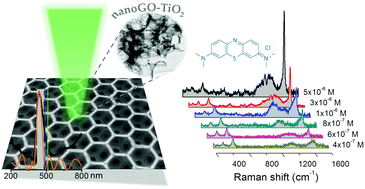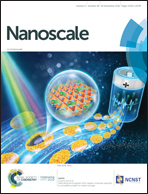Nanographene oxide–TiO2 photonic films as plasmon-free substrates for surface-enhanced Raman scattering†
Abstract
The development of nanostructured semiconductors with tailored morphology and electronic properties for surface-enhanced Raman scattering (SERS) has been attracting significant attention as a promising alternative to conventional coinage metal SERS substrates. In this work, functionalized TiO2 photonic crystals by graphene oxide nanocolloids (nanoGO) are demonstrated as highly sensitive, recyclable, plasmon-free SERS substrates that combine slow-photon amplification effects with the high adsorption capacity and surface reactivity of GO nanosheets. Comparative evaluation of photonic band gap engineered nanoGO–TiO2 inverse opal films was performed on methylene blue SERS detection under different laser excitations in combination with rigorous theoretical simulations of the photonic band structure. A very low detection limit of 6 × 10−7 M and an enhancement factor of 5 × 104 along with excellent self-cleaning performance and reusability could be achieved by the interplay of slow-photon effects assisted by interfacial charge transfer between the analyte and the nanoGO–TiO2 semiconducting substrate. Slow-photon management in combination with judicious engineering of chemical enhancement in photonic nanostructures is accordingly proposed as an advanced approach for the design of efficient dielectric SERS substrates.



 Please wait while we load your content...
Please wait while we load your content...